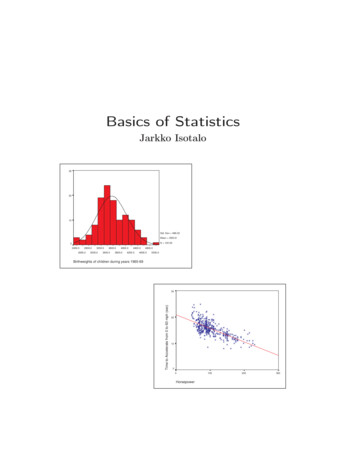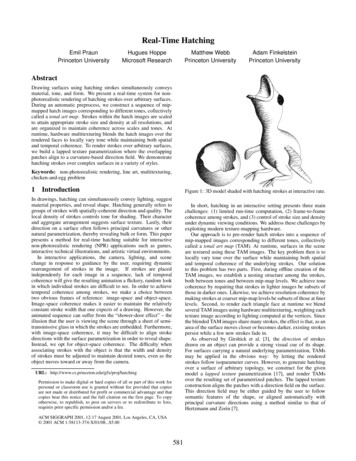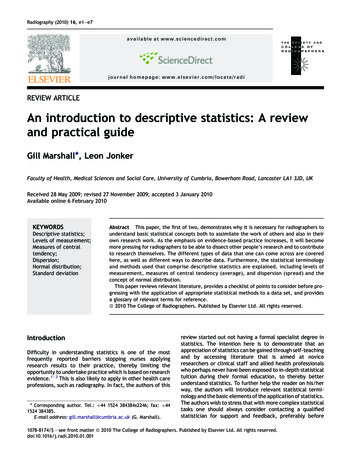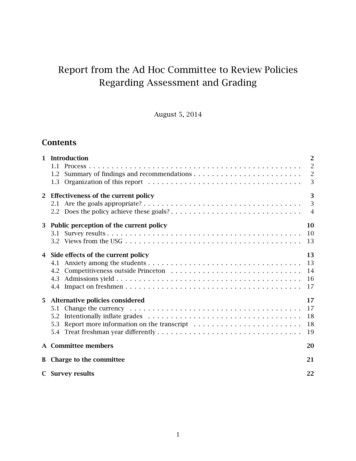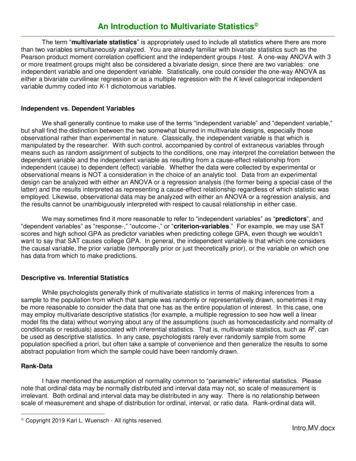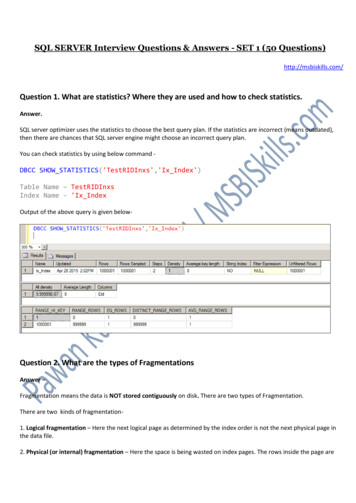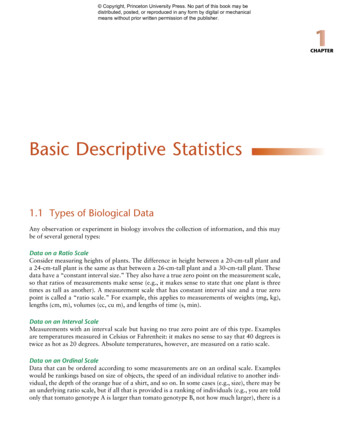
Transcription
Copyright, Princeton University Press. No part of this book may bedistributed, posted, or reproduced in any form by digital or mechanicalmeans without prior written permission of the publisher.1CHAPTERBasic Descriptive Statistics1.1 Types of Biological DataAny observation or experiment in biology involves the collection of information, and this maybe of several general types:Data on a Ratio ScaleConsider measuring heights of plants. The difference in height between a 20-cm-tall plant anda 24-cm-tall plant is the same as that between a 26-cm-tall plant and a 30-cm-tall plant. Thesedata have a “constant interval size.” They also have a true zero point on the measurement scale,so that ratios of measurements make sense (e.g., it makes sense to state that one plant is threetimes as tall as another). A measurement scale that has constant interval size and a true zeropoint is called a “ratio scale.” For example, this applies to measurements of weights (mg, kg),lengths (cm, m), volumes (cc, cu m), and lengths of time (s, min).Data on an Interval ScaleMeasurements with an interval scale but having no true zero point are of this type. Examplesare temperatures measured in Celsius or Fahrenheit: it makes no sense to say that 40 degrees istwice as hot as 20 degrees. Absolute temperatures, however, are measured on a ratio scale.Data on an Ordinal ScaleData that can be ordered according to some measurements are on an ordinal scale. Exampleswould be rankings based on size of objects, the speed of an individual relative to another individual, the depth of the orange hue of a shirt, and so on. In some cases (e.g., size), there may bean underlying ratio scale, but if all that is provided is a ranking of individuals (e.g., you are toldonly that tomato genotype A is larger than tomato genotype B, not how much larger), there is a
Copyright, Princeton University Press. No part of this book may bedistributed, posted, or reproduced in any form by digital or mechanicalmeans without prior written permission of the publisher.4Chapter 1loss of information if we are given only the ranking on an ordinal scale. Quantitative comparisons are not possible on an ordinal scale (how can one say that one shirt is half as orange asanother?).Data on a Nominal ScaleWhen a measurement is classified by an attribute rather than by a quantitative, numerical measurement, then it is on a nominal scale (male or female; genotype AA, Aa or aa; in the taxa Pinusor in the taxa Abies; etc.). Often, these are called categorical data because you classify the dataelements according to their category.Continuous vs. Discrete DataWhen a measurement can take on any conceivable value along a continuum, it is called continuous. Weight and height are continuous variables. When a measurement can take on only oneof a discrete list of values, it is discrete. The number of arms on a starfish, the number of leaveson a plant, and the number of eggs in a nest are all discrete measurements.1.2 Summary of Descriptive Statistics of DataSetsAny time a data set is summarized by its statistical information, there is a loss of information.That is, given the summary statistics, there is no way to recover the original data. Basic summarystatistics may be grouped as(i) measures of central tendency (giving in some sense the central value of a data set) and(ii) measures of dispersion (giving a measure of how spread out that data set is).Measures of Central TendencyArithmetic Mean (the average)If the data collected as a sample from some set of observations have values x1 , x2 , . . . , xn , thenthe mean of this sample (denoted by x̄) is1 x1 x2 · · · xn.xi nnnx̄ i 1Note the use of the notation in the above expression, that is,n xi x1 x2 · · · xn .i 1MedianThe median is the middle value: half the data fall above this and half below. In some sense,this supplies less information than the mean since it considers only the ranking of the data, nothow much larger or smaller the data values are. But the median is less affected than the meanby “outlier” points (e.g., a really large measurement or data value that skews the sample). TheLD 50 is an example of a median: the median lethal dose of a substance (half the individuals dieafter being given this dose, and half survive). For a list of data x1 , x2 , . . . , xn , to find the median,
Copyright, Princeton University Press. No part of this book may bedistributed, posted, or reproduced in any form by digital or mechanicalmeans without prior written permission of the publisher.Basic Descriptive Statisticslist these in order from smallest to largest. This is known as “ranking” the data. If n is odd, themedian is the number in the 1 n 12 place on this list. If n is even, the median is the average ofthe numbers in the n2 and 1 n2 positions on this list.Quartiles arise when the sample is broken into four equal parts (the right end point of the 2ndquartile is the median), quintiles when five equal parts are used, and so on.ModeThe mode is the most frequently occurring value (or values; there may be more than one) in adata set.MidrangeThe midrange is the value halfway between the largest and smallest values in the data set. So, ifxmin and xmax are the smallest and largest values in the data set, then the midrange isx̄mid xmin xmax.2Geometric MeanThe geometric mean of a set of n data is the nth root of the product of the n data values,x̄geom n 1/n xi nx1 · x2 · · · xn .i 1The geometric mean arises as an appropriate estimate of growth rates of a population whenthe growth rates vary through time or space. It is always less than the arithmetic mean. (Thearithmetic mean and the geometric mean are equal if all the data have the same value.)Harmonic MeanThe harmonic mean is the reciprocal of the arithmetic mean of the reciprocals of the data,nx̄harm n1i 1 xi n1x1 1x2 ··· 1xn.It also arises in some circumstances as the appropriate overall growth rate when rates vary.Example 1.1 (Describing a Data Set Using Measures of Central Tendency)After developing some heart troubles, John was told to monitor his heart rate. He wasadvised to measure his heart rate six times a day for 3 days. His heart rate was measuredin beats per minute (bpm).65 70 90 95 82 8461 83 120 83 72 7072 71 92 85 102 69(Continued)5
Copyright, Princeton University Press. No part of this book may bedistributed, posted, or reproduced in any form by digital or mechanicalmeans without prior written permission of the publisher.6Chapter 1(a) What was John’s mean heart rate over the 3 days? Calculate the three differentmeans (arithmetic, geometric, and harmonic).(b) What was John’s median heart rate?(c) What were the modes of John’s heart rate?(d) What was the midrange of John’s heart rate?Solution:(a) Arithmetic mean:x̄ 65 70 90 · · · 85 102 69 81.418Geometric mean:x̄geom (65 70 90 · · · 85 102 69)1 18 80.3Harmonic mean:x̄harm 181 1 1 ··· 1 1 16570908510269 79.2Notice that the three means do not yield equal values.(b) Arranging the numbers from smallest to largest, we get61 65 69 70 70 71 72 72 8283 83 84 85 90 92 95 102 120Since there are 18 data points, we take the average of the middle two numbers:82 and 83. Thus, the median is 82.5.(c) There are three modes in this data set: 70, 72, and 83.61 120 90.5. Notice that this is different from(d) Midrange: x̄mid 2the median.Measures of DispersionRangeThe range is the largest minus the smallest value in the data set: xmax xmin . This does notaccount in any way for the manner in which data are distributed across the range.VarianceThe variance is the mean sum of the squares of the deviations of the data from the arithmeticmean of the data. The best estimate of this (take a good statistics class to find out how best isdefined) is the sample variance, obtained by taking the sum of the squares of the differences of
Copyright, Princeton University Press. No part of this book may bedistributed, posted, or reproduced in any form by digital or mechanicalmeans without prior written permission of the publisher.Basic Descriptive Statisticsthe data values from the sample mean and dividing this by the number of data points minus one,s2 1 (xi x̄)2 ,n 1ni 1where n is the number of data points in the data set, xi is the ith data point in the data set x,and x̄ is the arithmetic mean of the data set x.Standard DeviationThe variance has square units, so it is usual to take its square root to obtain the standarddeviation, n 1 s variance (xi x̄)2 ,n 1i 1which has the same units as the original measurements. The higher the standard deviation s, themore dispersed the data are around the mean.Both the variance and the standard deviation have values that depend on the measurementscale used. So measuring body weights of newborns in grams will produce much higher variancesthan if the same newborns were measured in kilograms. To account for the measurement scale,it is typical to use the coefficient of variability (sometimes called the coefficient of variance): thestandard deviation divided by the arithmetic mean, which is dimensionless and has no units.This coefficient of variability is thus independent of the measurement scale used.Example 1.2 (Describing a Data Set Using Measure of Dispersion)In a summer ecology research program, Jane is asked to count the number of trees perhectare in five different sampling locations in King’s Canyon National Park in California.Each sampling location is referred to as a plot, and each plot is a different size. Here arethe data she collected:Plot Size (hectares)No. of Trees in Plot1.502.301.753.102.652031435829Given the data Jane collected, (a) construct the data set that represents the number oftrees per hectare for each of the five plots and then calculate the (b) range, (c) variance,and (d) standard deviation of the data set you constructed.(Continued)7
Copyright, Princeton University Press. No part of this book may bedistributed, posted, or reproduced in any form by digital or mechanicalmeans without prior written permission of the publisher.8Chapter 1Solution:(a) For each plot, the number of trees per hectare is# trees in plot.plot sizeFor example, the first plot has 20/1.5 13.3 trees/hectare. Thus, the data set thatrepresents the number of trees per hectare for each of the five plots isx {13.3, 13.5, 24.6, 18.7, 10.9}.(b) To calculate the range, we need to know xmax and xmin (the maximum andminimum values of the data set x). Looking at the data set constructed in (a),xmin 10.9 and xmax 24.6. Thus,range 24.6 10.9 13.7.(c) Recall that to calculate the variance of a data set, you must first know thearithmetic mean of that data set. For the data set constructed in (a),x̄ 13.3 13.5 24.6 18.7 10.9 16.2.5Then, the variance iss2 1(13.3 16.2)2 (13.5 16.2)2 (24.6 16.2)25 1 (18.7 16.2)2 (10.9 16.2)21( 2.9)2 ( 2.7)2 (8.4)2 (2.5)2 ( 5.3)241 [8.41 7.29 70.56 6.25 28.09]41 [120.6]4 30.15.(d) Recall that the standard deviation of a data set is the square root of the variance ofthat data set. Thus, the standard deviation iss 30.15 5.491.
Copyright, Princeton University Press. No part of this book may bedistributed, posted, or reproduced in any form by digital or mechanicalmeans without prior written permission of the publisher.Basic Descriptive StatisticsDispersion over Nominal Scale Data and the Simpson IndexAll the above measures of dispersion apply to ratio scale data. For nominal scale data, thereis no mean or variance that makes sense, but there certainly can be a measure of how spreadout the data are among the various categories, a concept called diversity. In ecology, the twomain factors taken into account when measuring diversity are richness and evenness. Speciesrichness is the number of different species present, while evenness is a measure of the relativeabundance of the different species making up the richness of an area. The area has unevendiversity if virtually all the individuals found are of one species with only rare individuals of theother species. The area has even diversity if all species have the same abundances. Simpson’sindex of diversity (SID) is one of several diversity indices. The SID represents the probability thattwo individuals randomly selected from a sample will belong to different species. In a certainarea or sample, letD S ni (ni 1),N(N 1)i 1where ni is the number of individuals in species i, N is the total number of individuals, and S isthe number of species. Then, the SID isSID 1 D.When SID is close to 1, the sample is considered to be highly diverse.1.3 Matlab SkillsIf you are not familiar with the software Matlab, review “Getting Started with Matlab” inAppendix A.Entering Data Sets in MatlabIn Matlab, data sets are entered as arrays, and arrays are denoted with square brackets: [ ]. Ifwe wanted to enter the trees per hectare data from Example 1.2, we would type[13.3 13.5 24.6 18.7 10.9]into Matlab. Notice that the data points in the set are separated by spaces. If we want to referback to this data set using Matlab, we need to name the data set. In Example 1.2, we called thedata set x. To call the data set x in Matlab, we typex [13.3 13.5 24.6 18.7 10.9]into Matlab. Now, whenever we want to refer back to our data set, we can just use x instead oftyping the entire data set again.9
Copyright, Princeton University Press. No part of this book may bedistributed, posted, or reproduced in any form by digital or mechanicalmeans without prior written permission of the publisher.10Chapter 1Table 1.1. Matlab commands for a variety of descriptive statistics. In each case, x refers to the data set.CommandDescriptionmean(x)Returns arithmetic mean of data set xprod(x)ˆ(1/length(x))Returns geometric mean of data set xgeomean(x)Returns geometric mean of data set x (using the Statistics Toolbox is available)length(x)/sum(1./x)Returns harmonic mean of data set xharmmean(x)Returns harmonic mean of data set x (using the Statistics Toolbox is available)median(x)Returns median of data set xmode(x)Returns mode of data set x(when there are multiple values occurring equally frequently,mode(x) Returns the smallest of those values)min(x)Returns minimum value of data set xmax(x)Returns maximum value of data set xvar(x)Returns the variance of data set xstd(x)Returns the standard deviation of data set xCalculating Descriptive Statistics in MatlabNow that we know how to enter our data sets into Matlab, we can use Matlab to quicklycompute basic descriptive statistics. Table 1.1 shows the commands for the descriptive statisticsdescribed earlier in this chapter.Each of the commands in Table 1.1 returns its corresponding answer and names the answerans. If we wish to save the answer for future use, we must name the output of the command.For example, if we wish to save the arithmetic mean, we can typexbar mean(x)into Matlab. If you are typing this into the command window, you will see that the value thatis returned is named xbar.Notice there are no commands for calculating the range or the midrange. We can calculatethese, however, by using the min and max commands. To calculate the midrange, we use(min(x) max(x))/2and to calculate the range, we usemax(x)-min(x)As an example, suppose we wanted to calculate the mean, median, mode, midrange, geometricmean, harmonic mean, range, variance, and standard deviation for the data set in Example 1.1.The following shows the input typed into the command window (always proceeded by ») andits corresponding output:
Copyright, Princeton University Press. No part of this book may bedistributed, posted, or reproduced in any form by digital or mechanicalmeans without prior written permission of the publisher.Basic Descriptive StatisticsCommand Window y [65 70 90 95 82 84 61 83 120 83 72 70 72 71 92 85 102 69]y Columns 1 through 1165709095828461831208372Columns 12 through 18707271928510269 ybar mean(y)ybar 81.4444 ymed median(y)ymed 82.5000 ymode mode(y)ymode 70 ymidrange (min(y) max(y))/2ymidrange 90.5000 ygeo geomean(y)ygeo 80.2747 yharm harmmean(y)yharm 79.1871 yrange max(y)-min(y)yrange 59 yvar var(y)yvar 217.3203 ystd std(y)ystd 14.74181.4 Exercises1.1The capacity for physical exercise (in seconds) was determined for each of 11 patientswho were being treated for chronic heart failure.906 1320 711 1170 684 1200 837 1056 897 882 1008(a) Determine the mean and the median of the data.(b) Determine the geometric and harmonic means of the data.(c) How do the three different measures of the mean differ?11
Copyright, Princeton University Press. No part of this book may bedistributed, posted, or reproduced in any form by digital or mechanicalmeans without prior written permission of the publisher.12Chapter 11.2Daily crude oil output (in millions of barrels) for the U.S. is shown below for the years1971 to 1990.9.45 9.40 9.25 8.75 8.30 8.10 8.25 8.70 8.55 8.608.55 8.65 8.70 8.70 8.91 8.60 8.20 7.70 7.20 6.75Compute the mean, median, and mode for the data.1.3Suppose the scale of a data set is changed by multiplying each measurement by a positiveconstant. How would this affect the mean, median, mode, and range?1.4Ten hospital employees on a standard American diet agreed to adopt a vegetarian dietfor 1 month. Below is the change in the serum cholesterol level (before after).49 10 27 13 361948 21 8 16(a) Compute the median and mean change in cholesterol.(b) Compute the range, variance, and standard deviation of the data. Are the data fairlyspread out or close together?1.5Twelve sheep were fed pingue (a toxin-producing weed of the southwestern United States)as a part of an experiment and died as a result. The time of death in hours after theingestion of pingue for each sheep follows:44 27 24 24 36 3644 120 29 36 36 36Compute the range, variance, and standard deviation of the sample.1.6The National Weather Service reports data on the number of hurricanes to strike theUnited States in decades in the last century (using the Saffir-Simpson category). Calculatethe mean of the number of hurricanes per 01981–19901990–20001.7No. of Hurricanes18211319241714121514Consider these two sets of data [71]:A {0, 5, 10, 15, 25, 30, 35, 40, 45, 50, 71, 72, 73, 74, 75, 76, 77, 78, 100}B {0, 22, 23, 24, 25, 26, 27, 28, 29, 50, 55, 60, 65, 70, 75, 85, 90, 95, 100}For both sets of data, calculate the range, median, the first quartile, and the third quartile.Do these values adequately represent the distribution in each data set?
Copyright, Princeton University Press. No part of this book may bedistributed, posted, or reproduced in any form by digital or mechanicalmeans without prior written permission of the publisher.Basic Descriptive Statistics1.8Suppose the mean score on a national test is 400 with a standard deviation of 50. If eachscore is increased by 25, what are the new mean and standard deviation?1.9Suppose the mean score on a national test is 400 with a standard deviation of 50. If eachscore is increased by 25%, what are the new mean and standard deviation?1.10 Use the following simple data set to calculate the SID for these trees in a particularplot [21]. Interpret your results as a probability.Species of TreesNo. of Trees in PlotEastern rosebudBlack oakPost oakWhite pineHoney locust345311.11 Below are some data from the Citizen Science program in the Great Smoky MountainsNational Park that record the species of salamanders observed in a particular area in2000 [21]. Calculate the SID for salamanders in this area using these data.SpeciesDesmogSpotted duskyBlack belliedSealBlue ridged Two linedImitatorSouthern redbackBlack chinnedNo. of Salamanders372216821113
Basic Descriptive Statistics 5 list these in order from smallest to largest. This is known as “ranking” the data. If n is odd, the median is the number in the 1 n 1 2 place on this list. If n is even, the

